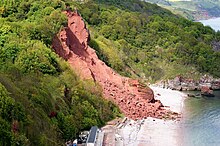
A rock slide is a type of landslide caused by rock failure in which part of the bedding plane of failure passes through intact rock and material collapses en masse and not in individual blocks. While a landslide occurs when loose dirt or sediment falls down a slope, a rock slide occurs only when solid rocks are transported down slope. The rocks tumble downhill, loosening other rocks on their way and smashing everything in their path.
Slides are rapid downslope movements of blocks along a bedding plane, joint, or area of weakness. The blocks tend to break up into smaller pieces as the slide moves downslope and large pieces collide with each other. These pieces can travel a great distance due to the force of the falling rock. For these slides, failure occurs along a well-defined shear plane; blocks of material within the failure may move as coherent units, preserving relict structures.
Rock slides can be some of the most dangerous forms of deformation because of the way that large rocks are traveling quickly down slope; this large material can cause massive damage to anything in its path.
The mode of failure is different from that of a rockfall in that the material is sliding or slumping down a slope instead of toppling off a cliff.
Fast-flowing rock slides or debris slides behave similarly to snow avalanches, and are often referred to as rock avalanches or debris avalanches.
Rock slides differ from other slides in that they involve solid rocks and not loose dirt or sediment falling down a slope. There are however, two different types of rock slides. Failure happens on a shear plane in both cases.
Slides occur where there is a tilted, pre-existing plane of weakness within a slope which serves as a slide surface for overlying rock to fall down.
Slumps are fairly small when compared to rock slides. Slumps form where the base of a slope is removed by natural processes (stream or wave erosion) or by human efforts (road or building construction). Removal of the lower part of a slope effectively removes physical support for the upper part of a slope, causing the formation of a new fracture in the sediment/rock comprising the slope. Soon thereafter, the slope will begin sliding downward, often rotating along the curved surface of rupture. Slumps can be rotational, where the land rolls into itself, and translational, where the entire slope gives way.
No comments:
Post a Comment